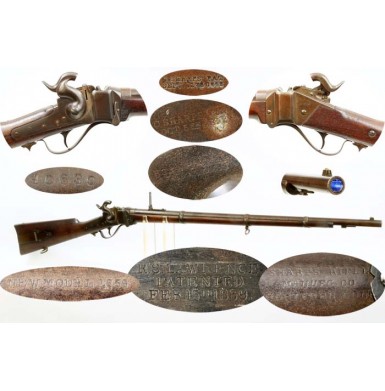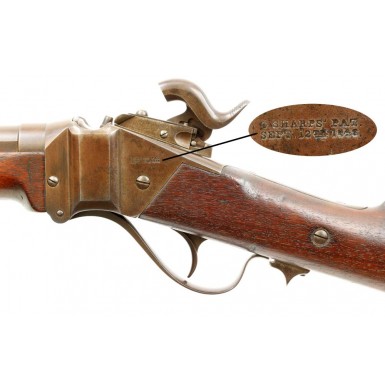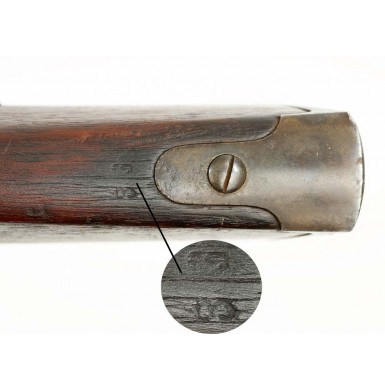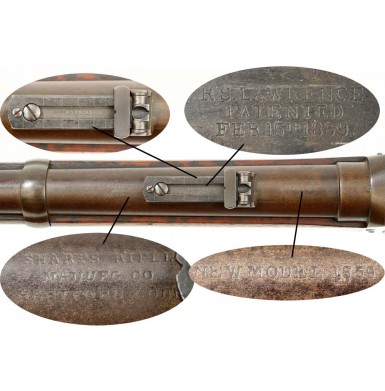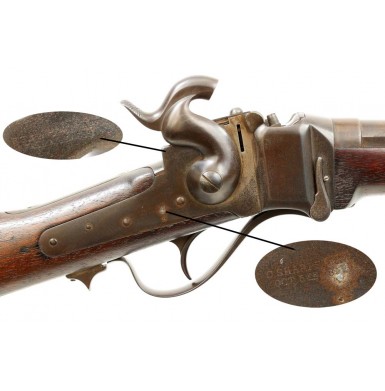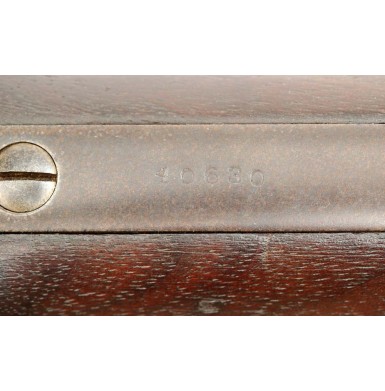Sharps NM-1859 Mitchell Contract Naval Rifle
- Product Code: FLA-3247-SOLD
- Availability: Out Of Stock
-
$1.00
The Sharps family of rifles & carbines are probably the most recognizable of all the breech loading firearms to be proven successful during the course of the American Civil War. Christian Sharps of Hartford, CT originated the revolutionary falling block design in the 1840s and his first long arm, the Model 1849 went into limited production in 1850. That same year the Sharps rifle was the only breechloading rifle to acquit itself positively in an early US military Board of Ordnance trial of new breechloading rifle systems. Due to the positive response from the trials board, Sharps was granted a small contract in 1851 to provide his newly designed Model 1851 carbines for field testing. Thus began a long relationship between Sharps and the US military that would continue for more than two decades. Over the 10-year period between the first US military Sharps contract and the outbreak of the American Civil War, a number of Sharps models were purchased by both the Army and the Navy for limited issue and use in the field. While it was clear to the Board of Ordnance that the Sharps designs were the best suited of the various breechloading carbine and rifle systems then available for military use, purchases remained rather small, as the Board was clearly prejudiced against the use of breechloading arms, preferring to continue the use of muzzleloading weapons. The US Navy certainly saw the potential promise of using a breechloading rifle aboard ship, and had previously utilized the Hall breechloading long arms, as well as the Navy specific Jenks designs. In 1856 the US Navy place an order for 150 (eventually raised to 200) Sharps Model 1855 Rifles in .54 with 27” barrels and equipped with saber bayonets. This order was followed in 1857 with an order for 100 Model 1855 carbines, which were essentially over-runs from a British contract, which had 18” barrels and were chambered for the English .577 bullet. The navy was happy enough with the performance of the Sharps arms that in 1859 they ordered 900 of the Sharps New Model 1859 Rifle, equipped to accept brass handled saber bayonets. These rifles were chambered for a non-standard Sharps caliber, rather than the usual .52, they were .56 caliber. These rifles appear scattered within the 33,000 to 34,000 serial number range. The order was somewhat fortuitous, as the deliveries from this order were completed during April of 1861, right at the outbreak of the Civil War. Practically all of these Sharps produced arms found themselves at sea in the early stages of the war, as an inventory of all US Navy yards, taken between June 1 and June 4 1861 revealed that only 14 of the 100 Sharps carbines owned by the navy were in storage and 80 of the 1,100 rifles were similarly available for issue. All other Sharps were already issued to ships. The sudden need for additional small arms to equip numerous new US naval vessels, resulted in additional orders for the popular Sharps rifle. On June 4, 1861 the US Navy contracted with Sharps’ agent in Washington D.C., John Mitchell, for 1,500 additional New Model 1859 Rifles equipped for saber bayonets. However, unlike the earlier order for NM-1859 Rifles, these were chambered in Sharps’ standard .52 caliber. The bayonets for these rifles were ordered directly from the Ames Manufacturing Company, rather than through Sharps. The order specified delivery of the rifles to the three major US Naval Yards then in operation, New York, Philadelphia and Boston, with 150 rifles to be delivered to each location no later than June 10, and the balance of the rifles to be delivered no later than June 25th. This impractical schedule could not be adhered to by Sharps, as the company was suddenly being asked to produce arms for the army, as well as the navy, on a scale they had not previously achieved. Amazingly the firm was able to complete the contract for 1,500 rifles by early August of 1861, no more than 6 weeks later than requested. These rifles were subsequently issued to a number of US naval vessels including the sloops Iroquois and Pensacola, the St. Lawrence and famous sloop Kearsarge. The Kearsarge was the American warship that sank the Confederate commerce raider Alabama off Cherbourg, France. The Alabama was commanded by the famous (or infamous) Confederate Captain Rafael Semmes, known during the period as “Semmes the Pirate”. According to the research of John D. McAulay, in addition to these NM-1859 rifles being issued for use on these ships, some 300 were sent to Cincinnati, OH for the use of the “Brown Water Navy”, the US gunboats operating on the Mississippi River. McAulay’s research further indicates that the rifles that were delivered as part of the “Mitchell Contract” were in the low 40,000 serial number range. Although the Sharps rifle appears to have worked well for the Navy and was relatively popular, when Sharps offered to sell an additional 500 NM-1859 rifles of various patterns to the Navy in July of 1862, after completing their US Army contract for Berdan’s Sharpshooters, the Navy demurred. However, at the end of the following month the navy did contract to buy some 10,000 .52 caliber cartridges for the NM-1859 Rifles that had been delivered the previous year. Instead the Navy appears to have spent 1862 focused on acquiring Sharps & Hankins Navy rifles and carbines to fill their breechloading weapons needs. While some 7,500 Sharps New Model 1859 Rifles were acquired by the US Military (both Army and Navy) between 1859 and the end of production circa 1863, only 2,400 of those were Naval purchases, or about 32%. Of those Naval purchases, 900 were the larger bore .56 caliber rifles and 1,500 were the more commonly encountered .52 caliber rifles from the Mitchell Contract, which only accounted for about 20% of US military acquired New Model 1859 Rifles. Like the pre-war NM-1859 contract, the wartime Mitchell Contract was for 30” barreled rifles with a lug under the barrel to accept a brass handled saber bayonet. The guns were blued with case hardened receivers and furniture, and the round barrels were secured by three solid barrel bands that were retained by springs. A long range Lawrence patent rear sight was mounted on the top of the barrel, forward of the breech and like the army contract rifles, a pair of sling swivels were provided. While the Sharps New Model 1859 rifles acquired by the Army went through a standard inspection process with sub-inspectors and a final inspection from a receiving officer from the Ordnance Department, the same is not true of the war time contract Sharps rifles. Some do appear from time to time with naval inspection marks on the patchbox hinge plate, but most do not. These Mitchell Contract New Model 1859 Rifles for the US Navy can usually only be identified by the configuration and serial number range.
Offered here is a VERY GOOD+ to NEAR FINE condition example of a Mitchell US Navy Contract Sharps New Model 1859 Rifle. The gun is one of the fairly scarce NM-1859 Rifles with a saber bayonet lug under the barrel, shows no inspection markings, and which falls in the correct serial number range for the Mitchell Contract arms. The rifle has the serial number 40630 clearly stamped on the tang, with the matching serial number 40630 under the barrel. The rifle also bears the rack number 56 on top of the stock comb, further indication of military use and issue. The barrel is marked SHARPS RIFLE / MANFG. CO. / HARTFORD, CONN in three lines, forward of the rear sight and NEW MODEL 1859 between the rear sight and the receiver. The Lawrence Patent sight base is marked in three lines as well: R.S. LAWRENCE / PATENTED / FEB 15TH 1859. The lock plate is marked in the center, behind the hammer, in two horizontal lines: C SHARPS’ PAT. / OCT. 5TH 1852 and is also marked near the top of the lock plate, behind the hammer: R.S. LAWRENCE PAT. / APRIL 12TH 1859. The left side of the breechblock is marked in two horizontal lines: C SHARPS PAT. / SEPT. 12TH 1848. The interior rear of the breechblock is clearly stamped R.S. LAWRENCE / PATENT / DEC. 20TH 1859 in three lines on the left side and H. CONANT / PATENT / APR. 1ST 1856 in three lines on the right side. As mentioned the rifle is in about VERY GOOD+ to NEAR FINE condition and retains some strong traces of original finish, combined with a really lovely and completely untouched plum-brown patina. The receiver, lock plate and hammer all have a deep, unmolested plum-brown patina, retain some trace hints of case coloring showing some mottled browns and blue flecks within the patina. The interior of the receiver shows nicely faded and dulled case coloring. The iron patch box retains a similar deep plum patina as well. The breechblock lever and trigger plate show a similar, slightly mottled plum brown coloration, with an even richer tobacco tone. The case hardened iron buttplate matches the balance of the furniture as well, as do the barrel bands and nose cap. The barrel retains some traces of the original factory blued finish on its surface, shown as flecks within the deep plum patina. The underside of the barrel, protected by the forend retains a strong amount of the original blue, maybe as much as 70% of the blue in the area that was protected. The metal of the rifle is free of any significant pitting, but does show some very lightly scattered flecks of minor surface oxidation and some lightly scattered areas of pinpricking, along with some very lightly scattered pitting on the receiver. The rifle has a very FINE bore, that remains nearly mirror bright and retains extremely crisp and sharp rifling. There is no real pitting to speak of visible in the bore, although there appears to be some minor frosting and possibly some scattered pinpricking in the grooves. A good scrubbing might bring the bore up to about mint condition. The action of the rifle works perfectly. Both the hammer and trigger system and the breechblock and lever work exactly as they should. The breech lever lock is also in place and fully functional. The Lawrence patent pellet primer system appears to be 100% complete and fully functional as well. This is nice, as the pellet priming system is often missing parts and completely non-functional, especially on the earlier production New Model 1859 rifles and carbines. The rifle retains the original long-range rear sight, as well as the original front sight and the previously mentioned saber bayonet lug. Both of the original sling swivels are also present on the rifle. The rifle has a FINE to VERY FINE condition stock and forend. Both pieces of wood are solid and complete without any breaks, cracks or repairs. Both are very crisp with very nice edges and no sign of ever having been sanded. Both piece of wood do show some scattered bumps, dings and surface mars from handling, storage and use, but show no signs of abuse or significant damage, other than a small chip forward of the rear swivel in the stock toe. The top of the comb, forward of the buttplate tang is stamped with a rack number which appears to read 56, no doubt the rack number or position the rifle held on the Civil War era US warship that the rifle was issued to.
Overall this is a really attractive and quite scarce Mitchell Contract Sharps New Model 1859 US Naval Rifle. The rifle is 100% complete, correct and un-messed with a really gorgeous and completely untouched patina. The gun remains very crisp and has a really wonderful look to it, giving it lots of eye appeal. The rifle is mechanically excellent with a fine stock and bore and retains strong legible markings throughout. These rifles are very scarce and with only 1,500 acquired are very difficult to find for sale. This rifle has survived in very nice, complete condition and would a wonderful addition to any collection of Sharps firearms or a US Navy small arms collection. The possibility that this rifle could well have been onboard the Kearsarge when she sank the Alabama only makes you wish that this rifle could talk and tell you its tales of adventure upon the high seas!
SOLD
